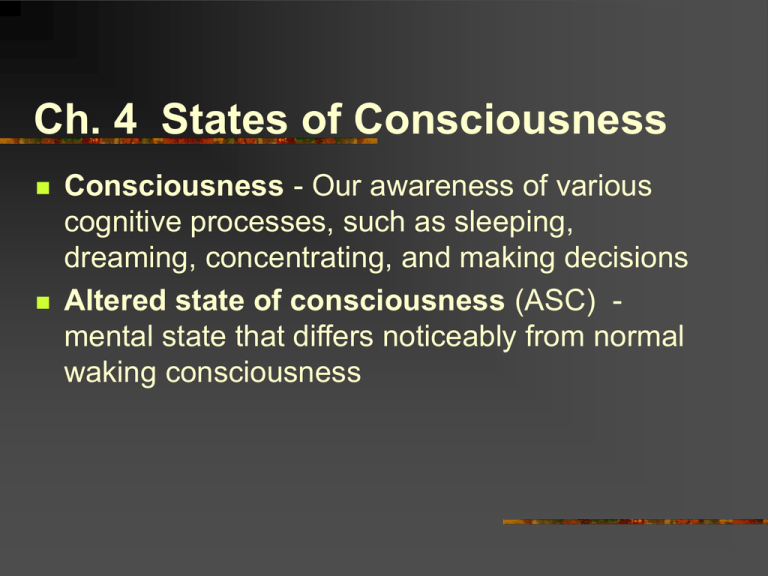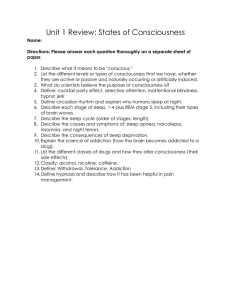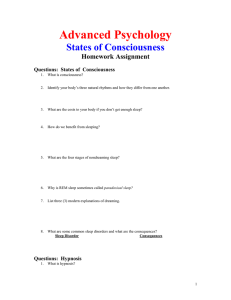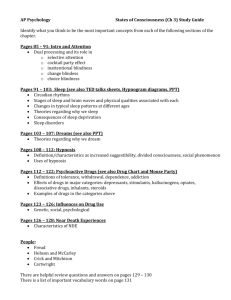Textbook PowerPoint
advertisement

Ch. 4 States of Consciousness Consciousness - Our awareness of various cognitive processes, such as sleeping, dreaming, concentrating, and making decisions Altered state of consciousness (ASC) mental state that differs noticeably from normal waking consciousness 1. Conscious Experience A. What is Waking Consciousness? B. Explaining Waking Consciousness Thoughts, feelings, and perceptions that arise when we are awake Stream of information resulting from the activity of the thalamus which analyzes and interprets information C. Daydreaming and Fantasy May provide stress relief and encourage creativity 2. Sleep A. Circadian Cycles: The Biological Clock Circadian = “about a day” B. The Rhythms of Sleep Brain waves and sleep stages Sleep stages 1- 4 REM versus non-REM REM more vivid dreams REM called paradoxical sleep Research into sleep patterns shows that normal sleep consists of several stages. Following the initial "twilight" state, which is characterized by irregular, low-voltage alpha waves and a state of relaxed wakefulness, the sleeper enters Stage 1 of sleep… REM sleep is also called paradoxical sleep because while brain activity and other physiological symptoms resemble those recorded during waking consciousness, the sleeper appears to be deeply asleep and is incapable of moving because of paralysis of the body's voluntary muscles Non-REM, or NREM sleep, refers to the nonrapid-eye-movement stages of sleep that alternate with REM stages during the sleep cycle C. Sleep Disorders Sleeptalking, sleepwalking, and night terrors More common in children Usually Stage 4 sleep Insomnia - Difficulty falling asleep or remaining asleep 35 million Americans May be related to stress, depression, medication Apnea Breathing stops momentarily during sleep Narcolepsy Suddenly falling asleep 3. Dreams A. Why Do We Dream? Dreams as unconscious wishes Freud “royal road to the unconscious” Dreams and neural activity Random outbursts of nerve-cell activity Dreams and waking life “Housecleaning” of information B. Do We Need to Dream? Reprocessing of information Can you learn while asleep? 4. Drug-Altered Consciousness A. Psychoactive Drugs B. Substance Use Chemicals that change mood and perceptions Movie Clip #1 Movie Clip #2 Using a substance but it does not yet interfere with a person’s life C. Substance Abuse Using substances to the point that the person becomes less responsible D. Substance Dependence Dependence on substance leads to tolerance and withdrawal Addiction Movie E. Tolerance and Withdrawal Tolerance More substance is required to obtain the same effect Withdrawal Physical discomfort when the substance is stopped Substance use may be essential for medical reasons and it may also be culturally approved and valued. By contrast, substance abuse is a pattern of drug use that diminishes the person's ability to fulfill responsibilities at home or at work or school, that results in repeated use of a drug in dangerous situations, or that leads to legal difficulties related to drug use F. Depressants Alcohol 2/3 fatal crashes Paradoxical stimulant Alcohol myopia Click here to view the Blood-Alcohol table Barbiturates Downers For insomnia, anxiety, epilepsy, arthritis, bedwetting Opiates Poppy seed or synthetic Heroin Opiates Movie G. Stimulants Caffeine Alertness Anxiety, headaches, heart palpitations, insomnia, diarrhea Nicotine Highly addictive Brain craves Nicotine Movie Caffeine is considered to be a benign drug, but in large doses it can cause anxiety, insomnia, and other unpleasant conditions Amphetamines Euphoria then crash, severe depression Amphetamines Movie Cocaine In Coca-Cola originally Euphoria (stim. Sympathetic NS) Crash leads to anxiety, depression, and cravings Cocaine Movie Click here to view the Depressants, Stimulants, and Hallucinogens table H. Hallucinogens and Marijuana Distort visual and auditory perception LSD Produces hallucinations and delusions similar to a psychotic state Can result in psychosis, memory loss, paranoia, panic attacks, nightmares and aggression Marijuana Mild hallucinations Euphoria, sense of well-being, relaxation Anxiety and paranoia Marijuana Video 5. Meditation and Hypnosis A. Meditation A technique which improves the ability to focus and relax B. Hypnosis Hypnotic suggestions Clinical application of hypnosis



